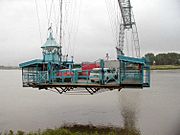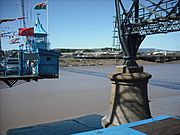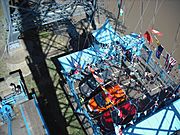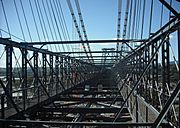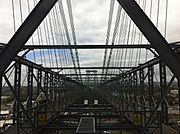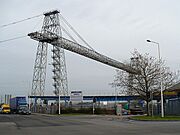Newport Transporter Bridge facts for kids
Quick facts for kids Newport Transporter Bridge |
|
|---|---|

The bridge viewed from Coronation Park
|
|
| Coordinates | 51°34′14″N 2°59′08″W / 51.57064°N 2.98556°W |
| Carries | Motor vehicles, cyclists and pedestrians including buses and multi sized lorries. |
| Crosses | River Usk |
| Locale | Newport, Wales |
| Official name | Newport Transporter Bridge |
| Maintained by | Newport City Council |
| Heritage status | Grade I |
| Characteristics | |
| Design | Transporter bridge |
| Total length | 236m (774.28 ft) |
| Width | Three cars (gondola) (total width 108 ft / 33 m) |
| Longest span | 196.56m (644.88 ft) |
| History | |
| Designer | Ferdinand Arnodin |
| Opened | 12 September 1906 |
| Statistics | |
| Toll | Adult Single – £1.50 Adult Return – £2.00 Child Single – 50p Child Return – £1.00 Day Ticket (inc. unlimited trips on the gondola and walking across the top of the bridge) – £4.00 |
The Newport Transporter Bridge (Welsh: Pont Gludo Casnewydd) is a very special kind of bridge. It crosses the River Usk in Newport, South East Wales. This bridge is unique because it carries people and cars across the river on a moving platform, instead of having them drive directly over it.
It's one of the lowest crossings over the River Usk. This amazing structure is also a Grade I listed building. This means it's a very important historical site.
There are fewer than 10 transporter bridges still working around the world. Only a few dozen were ever built! The Newport Transporter Bridge is one of only two still in use in Britain. The other one is the Tees Transporter Bridge.
Contents
History of the Bridge
The Newport Transporter Bridge was designed by a French engineer named Ferdinand Arnodin. It was built a long time ago, in 1906. The bridge officially opened on September 12, 1906. Godfrey Charles Morgan, 1st Viscount Tredegar, helped open it.
The Newport Museum has a silver cigar cutter from that day. It was given to Viscount Tredegar as a souvenir of the opening.
Why This Design?
Engineers chose this special design for a good reason. The river banks where the bridge stands are very low. If they built a regular bridge, it would need a super long ramp. This ramp would help ships pass underneath it.
Also, a ferry couldn't work well there during low tide. The river is also too narrow for a swing bridge or a bascule bridge (which is a type of drawbridge). So, a transporter bridge was the perfect solution!
How the Bridge Works
The towers of the bridge are about 73.6 meters (241 feet) tall. The main part of the bridge is 49.97 meters (164 feet) above the road. The distance between the two towers is 196.56 meters (645 feet).
The entire bridge, including its side sections, is 236 meters (774 feet) long. Two powerful 35-horsepower electric motors make the platform move. These motors power a large winch. The winch is in a special house at the eastern end of the bridge.
This system moves the platform, called a gondola, across the river. It travels at a speed of 3 meters (10 feet) per second.
The Newport Transporter Bridge is 5 meters (16 feet) taller than the Middlesbrough Transporter Bridge. However, it is 23 meters (75 feet) shorter overall. It also used less steel to build. This is because the Newport bridge uses strong cables to help support its structure.
The bridge is a Grade I listed structure. This means it's very important. It's known as the oldest and largest of the three historic transporter bridges left in Britain. It's also the largest of only eight such bridges still working worldwide.
More About the Bridge
Today, the Newport Transporter Bridge is a famous symbol of the city. It reminds everyone of Newport's industrial past. It's not just a way to cross the river; it's also a fun place to visit!
You can climb the towers and walk across the top deck. There's a small fee for this adventure. The bridge is also part of the National Cycle Network. Route 4 crosses the River Usk here, and Route 47 begins.
The bridge was a big part of the city's millennium celebrations in 2000. Fireworks were launched from it! It has also appeared in movies and TV shows. In 2006, it was the main attraction for the Crow Point Festival, celebrating its 100th birthday. People even do charity events like abseiling from it!
Bridge Upgrades
The bridge had to close in 1985 because it was getting old and worn out. After a big £3 million renovation, it reopened in 1995.
It closed again in December 2008 for more repairs. This time, it needed £2 million worth of work. Grants from the Welsh Government, Newport City Council, and Cadw helped pay for it. The bridge reopened on July 30, 2010. It had a brief closure in February 2011 but was back open by June 4 of that year.
Bridge in Movies and Music
The transporter bridge has been featured in several films. Some scenes from the 1959 British crime drama Tiger Bay were filmed there. It also appears in the 1972 experimental film The Other Side of the Underneath.
In 1996, the Newport band 60 Ft. Dolls used the bridge in their music video for the song "Talk to Me."
Visitor Centre
The Visitor Centre is on the west side of the bridge. It has cool exhibits about the bridge's history. You can learn how it was built and see information about other transporter bridges.
Inside, there's a painting of David Pearce. He was a famous Welsh and British Heavyweight Boxing Champion. David Pearce used to run up the bridge steps as part of his training!
The centre is usually open on weekends. It was closed for a while for bridge restoration and to build a new visitor centre. It reopened in Summer 2024, so it is now open for visitors to enjoy.
Gallery
See also
- List of bridges in Wales



